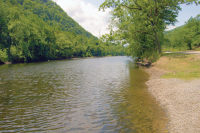Wilderness proponents flummoxed by not-in-my-back-yard mindset
A movement to create new wilderness areas in the Pisgah and Nantahala national forests has met resistance in the seven western-most counties.
County commissioners have gone on record in recent months opposing new wilderness areas, claiming it would limit recreation and logging.
But proponents of more wilderness areas claim it would add value to the recreation landscape and still leave plenty of national forest land for logging.
“Fundamentally it is a false dichotomy. They don’t have to be mutually exclusive,” said Ben Prater, conservation director for Wild South.
Haywood and Swain commissioners passed their own versions of the anti-wilderness area resolutions in February, joining Macon, Graham, Clay and Cherokee counties already on record. Jackson commissioners are the only ones in the seven western counties who haven’t weighed in yet.
Haywood’s resolution resisting new wilderness areas differs in key ways from those passed by the counties further west, however. The resolutions passed by other counties centered around wilderness areas being off-limits to logging as the chief reason for their opposition.
Related Items
SEE ALSO: Forest Service backs off planning timeline
“Ours is different and that was intentional. We didn’t want to make a political statement about timbering,” Haywood Commissioner Mark Swanger said. “People are so polarized on that issue you can’t change any minds. You’re either for it or against it.”
Instead, Haywood commissioners feared wilderness designation would limit recreation, which is important to the tourism economy.
“If you close off areas and don’t maintain trails then people can’t enjoy and use it,” Commissioner Mike Sorrells said.
Haywood commissioners feared the forest service would essentially abandon areas that were designated as wilderness. Trails would fall into disrepair, trails would be closed, access would be curtailed, trail signs would be absent and roads wouldn’t be kept up, they said during discussion of the resolution last month.
“If you manage for wilderness you kind of just let it go.” County Manager Ira Dove said.
But that’s not necessarily the case, said Heather Luczak, the forest planning coordinator for the Pisgah and Nantahala national forests.
The only forms of recreation that are banned outright in wilderness areas are mountain biking and four-wheelers. Hiking, camping, fishing, hunting and horseback riding are all allowed in wilderness.
“Wilderness doesn’t mean you can’t have trails,” said Jill Gottesman, conservation specialist with The Wilderness Society’s Southern Appalachian field office based in Sylva. “It would not lead to the lack of maintenance of roads and trails or reduced recreational use as the resolution claims.”
To the contrary, wilderness areas are a sought-after recreation experience, Gottesman said, pointing to the 50,000 annual visitors to Shining Rock Wilderness Area in Haywood County.
“People value places where you can’t go in on a four-wheeler,” Gottesman said. “One of the things they look for is the opportunity for solitude and that is getting more and more endangered as our population grows and our public lands get more fragmented.”
While trails may not be closed outright, Swanger countered that trails wouldn’t be kept up and would in turn compromise the hiking experience. In wilderness areas, trail work can only be done on foot and only with hand tools. Trail crews have to hike in for miles carrying crosscut saws, loppers and adzes to repair and maintain trails, and that could lead to a slow erosion of the trail quality and availability, Swanger postulated.
Luczak said that’s not necessarily the case.
“I don’t know if that is a conclusion you can draw because we have a lot of dedicated trail groups that are trained in trail maintenance in wilderness areas,” Luczak said.
Haywood’s resolution also cited concerns over search and rescue operations being impaired by wilderness area restrictions on four-wheelers.
Haywood commissioners postulated that the forest service is advocating for more wilderness areas as a cost-cutting measure.
“I think they are trying to make their resources go further,” Swanger said. “There seems to be a movement by the federal government to spend as little as humanly possible on national parks and forests.”
Wilderness designation means the forest service is off the hook, said commissioners.
“They just don’t want to mange it and take care of it,” Commissioner Kirk Kirkpatrick said.
Why the wilderness talk?
Ironically, the forest service isn’t actually proposing new wilderness areas. The county resolutions are more of a pre-emptive move in a hypothetical debate over whether to create more wilderness areas, and if so, where.
A sweeping revision of the Pisgah and Nantahala forest management plan is underway — it’s mandated every 20 to 30 years — to reassess the playbook for recreation, ecological habitat, logging and more.
It’s still early in the multi-year process. The first step is taking inventory of the “state of the forest.” That inventory includes a list of areas that could theoretically qualify as wilderness, given their characteristics.
More than four dozen areas in the Pisgah and Nantahala were flagged as “eligible” for wilderness on the initial laundry list.
“It is supposed to be broad and inclusive. The next step is you evaluate the areas,” Luczak said.
How many will make the cut is a long way off.
But commissioners are hoping to head off the idea of additional wilderness area before they can gain any traction. After all, there is a list.
“We are responding to the reality of what was put out,” Dove said.
The only real prospect for additional wilderness area is expanding the existing Shining Rock and Middle Prong from 26,000 acres to 32,000 acres. And those areas are already under a light-touch management protocol as designated roadless areas, so wilderness designation would merely consecrate how they are being managed already, Prater said.
A section of Harmon Den along the Tennessee line in northern Haywood is also on the initial laundry list, but it didn’t make the short list of priority areas being lobbied for by conservation groups and thus is unlikely to move forward.
A loose-knit conglomerate with a stake in the national forests has been hashing out mutually agreeable elements of a forest plan under a banner called Pisgah-Nantahala Forest Partnership.
Prater said county commissioners seem to be precluding themselves from that larger regional conversation by putting their foot down without first hearing out alternative views.
“Resolutions like this make it harder to collaborate,” Gottesman agreed.
Haywood commissioners passed their resolution without an opportunity for public comment, giving the impression it speaks for the constituency despite the public being unaware such a resolution was in play, Prater said.
The same was true in Macon and Swain, where the resolutions were passed at the same meeting where they were first introduced, giving members of the public no opportunity to share alternative views on the issue.
Swanger said he didn’t think the issue was controversial in Haywood County and thus it was unnecessary to hold off on a vote to allow for the public to weigh in. Haywood commissioners defended their prompt passage of the resolution the same day it was introduced, citing a discussion of the forest planning process that came up at a meeting nine months earlier. However, there had been no public mention of the issue by commissioners since then, let alone a warning that a resolution was coming down the pike in February.
With so many county boards proffering similar versions of an anti-wilderness resolution, environmental groups have questioned who might be behind them.
“I believe these resolutions are being used as a political vehicle by an outspoken minority with a very specific interest,” Gottesman said.
Special interest groups that support logging lobbied for the resolutions behind the scenes in some of the more western counties. But that wasn’t the case in Haywood, Dove said. Dove said Haywood drafted its own resolution language after following the forest plan process.
“We are looking at it from more of a public purpose perspective. Are they making it better by proposing this? We think not,” Swanger said.
A new conversation
Haywood commissioners’ concern over wilderness designation reflects a larger shift in national forest management over the past two decades. Historically, national forest debates have pitted loggers against environmentalists and outdoor recreation enthusiasts. These days, logging is a minor player in the national forest framework. The new discourse finds recreation groups and environmentalists juggling the growing demand for outdoor recreation within a finite pool of public land.
Wilderness areas are off-limits to logging. But logging aside, manipulation of the ecosystem in other ways is vastly curtailed in wilderness as well. And that was cited as a concern in Haywood’s resolution.
In wilderness areas, the forest service can’t easily intervene against unpleasant natural forces — whether it’s storm cleanup, invasive pests that leave dead stands or the fallout from global warming on forest ecosystems.
“If the area becomes wilderness we have very limited tools we can use for management,” Luczak said.
Too much, too little, just right?
There’s 600,000 acres of national forest land in the seven western counties, and 53,500 acres are within wilderness areas — a little under 9 percent. They are:
• Joyce-Kilmer Slickrock: 13,500 acres (Graham)
• Southern Nantahala: 10,900 acres (Macon and Clay)
• Ellicott Rock: 3,000 acres (Macon)
• Shining Rock: 18,500 acres (Haywood)
• Middle Prong: 7,500 acres (Haywood)
There’s also two wilderness study areas, a federal recommendation that carries wilderness protections but lacks full-blown designation.
• Snowbird: 9,000 acres (Graham)
• Overflow: 4,000 acres (Macon)
A new forest management plan is underway that could set the ball in motion for additional wilderness areas. The national forest service can recommend new wilderness areas, but it takes an act of Congress to make them official. For more information about controversial points of the forest plan, see page 7.









